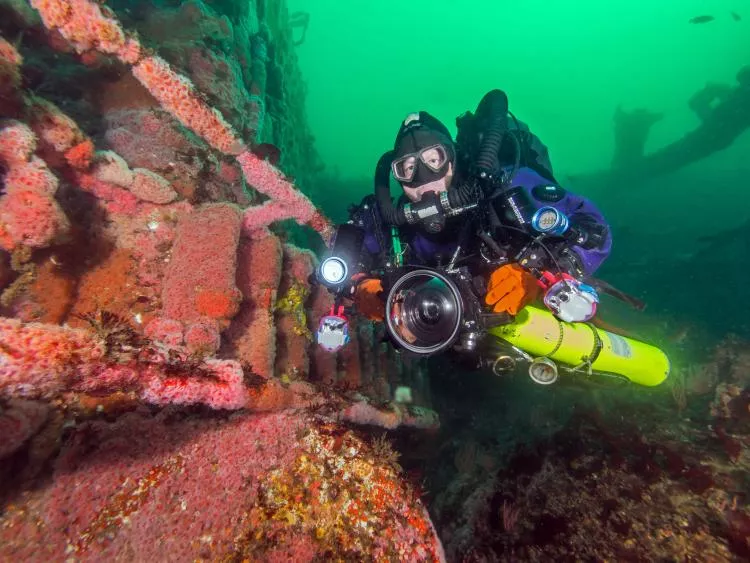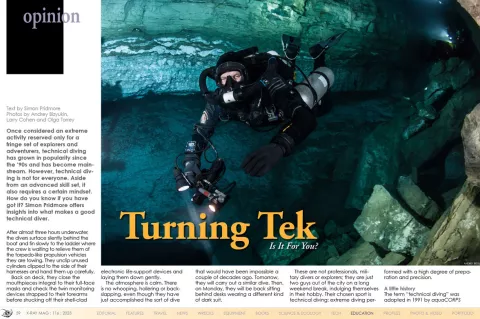Once considered an extreme activity reserved only for a fringe set of explorers and adventurers, technical diving has grown in popularity since the ‘90s and has become mainstream. However, technical diving is not for everyone. Aside from an advanced skill set, it also requires a certain mindset. How do you know if you have got it? Simon Pridmore offers insights into what makes a good technical diver.
Contributed by
After almost three hours underwater, the divers surface silently behind the boat and fin slowly to the ladder where the crew is waiting to relieve them of the torpedo-like propulsion vehicles they are towing. They unclip unused cylinders clipped to the side of their harnesses and hand them up carefully.
Back on deck, they close the mouthpieces integral to their full-face masks and check the twin monitoring devices strapped to their forearms before shucking off their shell-clad electronic life-support devices and laying them down gently.
The atmosphere is calm. There is no whooping, hollering or backslapping, even though they have just accomplished the sort of dive that would have been impossible a couple of decades ago.
Tomorrow, they will carry out a similar dive. Then, on Monday, they will be back sitting behind desks wearing a different kind of dark suit.
These are not professionals, military divers or explorers; they are just two guys out of the city on a long weekend break, indulging themselves in their hobby. Their chosen sport is technical diving: extreme diving performed with a high degree of preparation and precision.
A little history
The term “technical diving” was adopted in 1991 by aquaCORPS magazine founder Michael Menduno to describe the activities of a number of disparate groups of adventurers and explorers who were using military and commercial diving technology, ideas, equipment and decompression tables to make dives well beyond the bounds of normal sport scuba, as safely as possible.
A community coalesced, procedures were tried and tested, specialised training agencies were established, information was shared, and news spread quickly. This was the most exciting development in diving in decades.
Some people in the sport’s mainstream were appalled at its popularity. They forecast disaster. They feared that members from the extreme outer reaches of the sport, who were leading the charge, would act irresponsibly, leading to a spate of diver deaths, destroying scuba’s carefully crafted image as a “sport for all” and attracting government intervention and regulation—something scuba diving had always managed to avoid, at least in the USA, mainly thanks to its excellent safety record.
Publicity campaigns were launched, encouraging divers to reject this “dangerous” new trend and seeking to set deep planned-decompression mixed-gas diving apart from the mainstream. Sport divers should stick to air, no decompression-stop diving, no overhead-environment diving and a maximum depth of 39m (130ft), they said.
Anyone who engaged in activities beyond these limits was not a sport diver. They were outliers, to be ignored and excluded by the sport-diving world. This had been the attitude towards cave divers since the 1960s—not that the cave divers cared.
But the lure of hitherto unimagined opportunities was too strong; divers continued to queue up to acquire the necessary equipment and training, and the feared deluge of diver deaths did not transpire. Before long, the sport-diving hierarchy gave in to popular demand, and today, plenty of technical diving initiatives, such as nitrox, delayed surface marker buoys and harness-and-wing BCDs, have become part of mainstream diving, and most sport-diver training agencies offer technical diving courses.
A particular mindset
So, what is technical diving? Many think of technical divers as crazed individuals dressed head-to-toe in black, foolhardily festooned in the contents of a small dive shop, launching themselves into the depths without a thought for their own safety. This image is reinforced by the common practice of defining technical diving in terms of the extreme nature of the dive or the equipment used—for instance, a dive below 40m (130ft) or deep penetration inside an overhead environment such as a cave or shipwreck.
The true definition of technical diving owes far more to the mindset of the diver than the particulars of the dive. A technical approach to a dive involves objective analysis of the risks involved and calculation of the type and amount of gas required and the right equipment to use. It also involves the consideration of what potentially life-threatening events might occur on the dive and an assessment of the skills and backup equipment that the diver will need to be armed with in order to survive.
Motivation
Contrary to common misconception, very few people come into technical diving drawn by the quest for a thrill or adrenaline rush. After all, rather than court danger, the whole ethos of the sport is to counter risk through the application of planning, training and technology. Most technical divers are thoughtful people who are attentive to detail, sometimes to an obsessive degree.
Most early technical divers were explorers driven to go further to set records, visit virgin shipwrecks, solve maritime mysteries, penetrate flooded cave systems, learn more about the sea, and record and research marine life. Some of those that have followed them share similar ambitions, but there are also those who are just motivated by curiosity, a desire to test themselves or a fascination with the science and technology involved.
Technical diving is not for everyone. Some of the best divers in the world may use nitrox and may have adapted some of their equipment after seeing what technical divers use and how they streamline themselves, but they have no need to go deep or into flooded caves or wrecks, or encumber themselves with extra equipment. Being a technical diver does not mean you are necessarily a better diver than others.
There are also some people around who really should never go anywhere near technical diving because they do not have the right mindset. How can you tell in advance if this is you? Would you make a good technical diver?
Here are a few essential prerequisites and some red flags to be aware of.
Experience
It does not matter how many certification cards you hold or how many dives you have done. The nature of the diving you have done matters more. You should have been exposed to some relatively testing marine environments and water conditions and managed to stay comfortable and calm before you embark on technical diver training.
Self-reliance
In the technical diving world, you will perform as an independent part of a mutually supportive team, always responsible for your own dive but always ready to assist a teammate if necessary. Technical diving is not for the selfish or self-obsessed.
Competence
You need to have mastered standard scuba diving skills before progressing to this level. This means, for example, being able to control your buoyancy instinctively and effortlessly, and being completely comfortable not wearing your mask underwater. You should also have a firm understanding of decompression theory.
Self-discipline
You must be able to stick to a dive plan. While standard no-decompression single-cylinder diving offers guidelines to follow, technical diving has strict rules based on physiological and physical limits. Your life and the lives of your teammates depend on you sticking to a plan and being able to resist any narcosis-fuelled urges to abandon it and make up a new plan on the fly.
Meticulousness
If you are the type of diver who regularly jumps in without securing your BCD to the cylinder or turning your air on, then technical diving is not for you. Ask the people you dive with. Do they privately think that you are an accident waiting to happen? If they do, listen to them.
Fitness
You should be mentally and physically fit. Technical divers carry more gear, swim farther and stay underwater longer.
Acceptance of risk
Technical diving involves a higher level of risk. Are you prepared to accept this? Is your family also prepared?
Financial health
Finally, technical diving requires a substantial investment in training, equipment and travel. There are no shortcuts. Cheap training at this level is likely to be inadequate training. If you cannot afford to do it the right way, do not do it at all.
Open or closed?
If you (and your friends) see no red flags, then your next decision is whether to stay with open-circuit or buy a rebreather. Now is the time to make this choice—if you can—before you start technical diver training. If you are expecting eventually to be diving below 50m (165ft), and therefore using mixes heavy on helium, then closed-circuit really is the only way to go, as the quantities of helium required for deep open-circuit diving make it extremely expensive. And helium will only become pricier as the years go by. It is a finite resource, and scuba divers are not at the head of the line to purchase it. We even come behind balloon sellers!
Yes, rebreathers are expensive to buy, but once you start using helium, you will earn back your investment very quickly, because your costs will be much, much lower than they would be if you did the same dives with open-circuit equipment. These days, it is rare to see any open-circuit divers on deep-diving trips.
If you do technical diver training on open-circuit equipment, and then subsequently decide to buy a rebreather, your certification levels are not transferrable. You must begin all over again, with a shallow depth limit and no planned decompression, and work your way back up, logging a number of dives at each level along the way. This will take some time, as I mention below.
Once you dive with a rebreather for the first time, you will see how much sense this makes. Closed-circuit diving is a new world, and the best way to approach it is with the mindset that you are learning to dive all over again, keeping your mind entirely open to new ways of thinking and doing things.
Concluding thoughts
Technical diving is challenging and rewarding, and it can take you to places on our planet seen first-hand by very few. Whichever path you choose, you have a lot to learn before you get there, so prepare for a lengthy journey. There are several levels of training to pass through, and the courses only scratch the surface in terms of experience, just introducing you to the concepts and allowing you a few practice dives under supervision.
You then need to do plenty of diving to assimilate the new techniques and build your skills before moving on to the next level. So, take it slowly, enjoy the journey and do not let anyone rush you. There is no finishing line. You will never be as good as you can be.




























